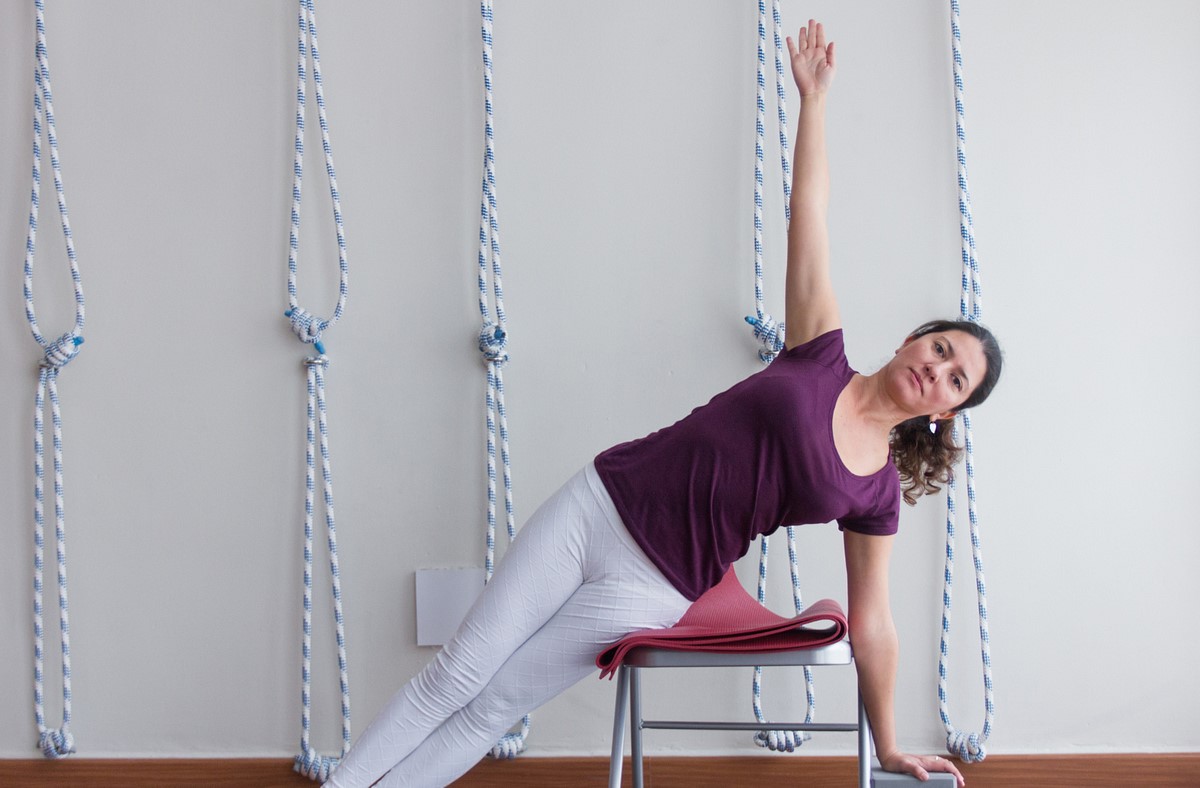
Iyengar Yoga is a form of yoga that emphasizes precision, alignment, and detail in each pose. Named after its founder, B.K.S. Iyengar, this practice uses props like belts, blocks, and blankets to help practitioners achieve the correct form. What makes Iyengar Yoga unique? It's the focus on holding poses for longer periods and the meticulous attention to body alignment. This method not only builds strength and flexibility but also enhances mental clarity and concentration. Whether you're a beginner or an experienced yogi, Iyengar Yoga offers benefits that cater to all levels. Ready to dive into the world of Iyengar Yoga? Let's explore 50 fascinating facts about this transformative practice!
Key Takeaways:
- Dive into the world of Iyengar Yoga, a practice rooted in ancient wisdom and mindfulness. From its origins to its global influence, discover the unique features and health benefits that make it a vibrant and accessible yoga style.
- Experience the legacy of B.K.S. Iyengar through his family and dedicated practitioners worldwide. Explore the advanced practices, community culture, and ways to integrate Iyengar Yoga into daily life for balance and harmony.
Origins and History of Iyengar Yoga
Iyengar Yoga, developed by B.K.S. Iyengar, has a rich history rooted in traditional Indian practices. Here are some fascinating facts about its origins and evolution.
- B.K.S. Iyengar: Born in 1918, B.K.S. Iyengar is the founder of Iyengar Yoga. His teachings have influenced millions worldwide.
- Patanjali's Yoga Sutras: Iyengar Yoga is based on the ancient Yoga Sutras written by Patanjali, a sage from India.
- First Book: B.K.S. Iyengar's book "Light on Yoga," published in 1966, is considered the bible of modern yoga.
- Guruji: B.K.S. Iyengar is often referred to as "Guruji" by his students and followers.
- Ramamani Iyengar Memorial Yoga Institute: Established in Pune, India, in 1975, this institute is the heart of Iyengar Yoga.
Principles and Philosophy
The principles and philosophy of Iyengar Yoga emphasize precision, alignment, and mindfulness. These core elements set it apart from other yoga styles.
- Alignment: Iyengar Yoga focuses on the precise alignment of the body in each pose.
- Props: Props like blocks, belts, and blankets are used to help students achieve proper alignment.
- Sequencing: Poses are sequenced in a specific order to maximize their benefits.
- Mindfulness: Practitioners are encouraged to be mindful and present during their practice.
- Breath Control: Pranayama, or breath control, is an integral part of Iyengar Yoga.
Health Benefits
Iyengar Yoga offers numerous health benefits, both physical and mental. Here are some key advantages.
- Flexibility: Regular practice improves flexibility and range of motion.
- Strength: It builds strength in muscles and joints.
- Posture: Enhances posture and reduces the risk of back pain.
- Stress Relief: Helps in reducing stress and anxiety.
- Balance: Improves balance and coordination.
Unique Features
Several unique features distinguish Iyengar Yoga from other yoga styles. These characteristics make it accessible to a wide range of practitioners.
- Adaptability: Suitable for all ages and fitness levels.
- Therapeutic: Often used for therapeutic purposes to address specific health issues.
- Detailed Instructions: Teachers provide detailed instructions to ensure proper alignment.
- Longer Holds: Poses are held for longer durations to deepen the practice.
- Teacher Training: Iyengar Yoga teachers undergo rigorous training and certification.
Global Influence
Iyengar Yoga has a significant global influence, with practitioners and centers worldwide. Here are some facts about its international reach.
- International Centers: There are Iyengar Yoga centers in over 70 countries.
- Yoga Journal: B.K.S. Iyengar was featured on the cover of Yoga Journal multiple times.
- UNESCO Recognition: In 2016, yoga, including Iyengar Yoga, was added to UNESCO's Intangible Cultural Heritage list.
- Global Day of Yoga: Celebrated on June 21st, this day honors the practice of yoga worldwide.
- Celebrity Practitioners: Many celebrities, including Madonna and Sting, practice Iyengar Yoga.
Advanced Practices
Advanced practitioners of Iyengar Yoga delve deeper into the practice, exploring more challenging poses and techniques.
- Inversions: Advanced poses include inversions like headstands and shoulder stands.
- Backbends: Deep backbends are a hallmark of advanced Iyengar practice.
- Arm Balances: Arm balances require strength and precision.
- Advanced Pranayama: More complex breath control techniques are practiced.
- Meditation: Meditation is integrated into advanced practice for mental clarity.
Community and Culture
The Iyengar Yoga community is vibrant and supportive, fostering a culture of learning and growth.
- Workshops: Regular workshops and retreats are held worldwide.
- Conventions: International conventions bring practitioners together to learn and share.
- Online Classes: Many teachers offer online classes, making Iyengar Yoga accessible globally.
- Books and Resources: Numerous books and resources are available for students.
- Mentorship: Senior teachers mentor newer practitioners, ensuring the tradition continues.
Iyengar Yoga in Daily Life
Incorporating Iyengar Yoga into daily life can bring balance and harmony. Here are some ways it can be integrated.
- Morning Routine: Practicing in the morning sets a positive tone for the day.
- Work Breaks: Short yoga breaks during work can reduce stress and increase productivity.
- Family Practice: Practicing with family members can strengthen bonds.
- Travel Practice: Portable props make it easy to practice while traveling.
- Mindful Living: Encourages mindfulness in everyday activities.
Iyengar Yoga for Specific Needs
Iyengar Yoga can be tailored to meet specific needs, making it a versatile practice.
- Pregnancy: Special sequences are designed for pregnant women.
- Seniors: Gentle poses and props make it accessible for seniors.
- Athletes: Helps athletes improve performance and prevent injuries.
- Children: Fun and engaging sequences are created for children.
- Chronic Conditions: Used to manage chronic conditions like arthritis and hypertension.
Continuing the Legacy
The legacy of B.K.S. Iyengar continues through his family and dedicated practitioners worldwide.
- Geeta Iyengar: B.K.S. Iyengar's daughter, Geeta, was a renowned teacher and author.
- Prashant Iyengar: His son, Prashant, is also a respected teacher and author.
- Abhijata Iyengar: His granddaughter, Abhijata, continues to teach and promote Iyengar Yoga.
- Annual Celebrations: B.K.S. Iyengar's birthday is celebrated annually by practitioners.
- Ongoing Research: Research on the benefits of Iyengar Yoga continues, contributing to its growth and popularity.
Final Thoughts on Iyengar Yoga
Iyengar Yoga offers a unique blend of precision, alignment, and mindfulness. Its emphasis on props makes it accessible to everyone, regardless of age or physical condition. Practicing Iyengar Yoga can improve flexibility, strength, and mental clarity. It’s not just about the physical postures; it’s a holistic approach to well-being. The methodical nature of Iyengar Yoga helps practitioners develop a deeper understanding of their bodies and minds. Whether you're a beginner or an experienced yogi, this style has something valuable to offer. Its benefits extend beyond the mat, promoting a balanced and harmonious lifestyle. So, if you're looking to enhance your yoga practice or start a new journey, Iyengar Yoga might be the perfect fit. Give it a try and experience the transformative power of this ancient practice.
Frequently Asked Questions
Was this page helpful?
Our commitment to delivering trustworthy and engaging content is at the heart of what we do. Each fact on our site is contributed by real users like you, bringing a wealth of diverse insights and information. To ensure the highest standards of accuracy and reliability, our dedicated editors meticulously review each submission. This process guarantees that the facts we share are not only fascinating but also credible. Trust in our commitment to quality and authenticity as you explore and learn with us.


